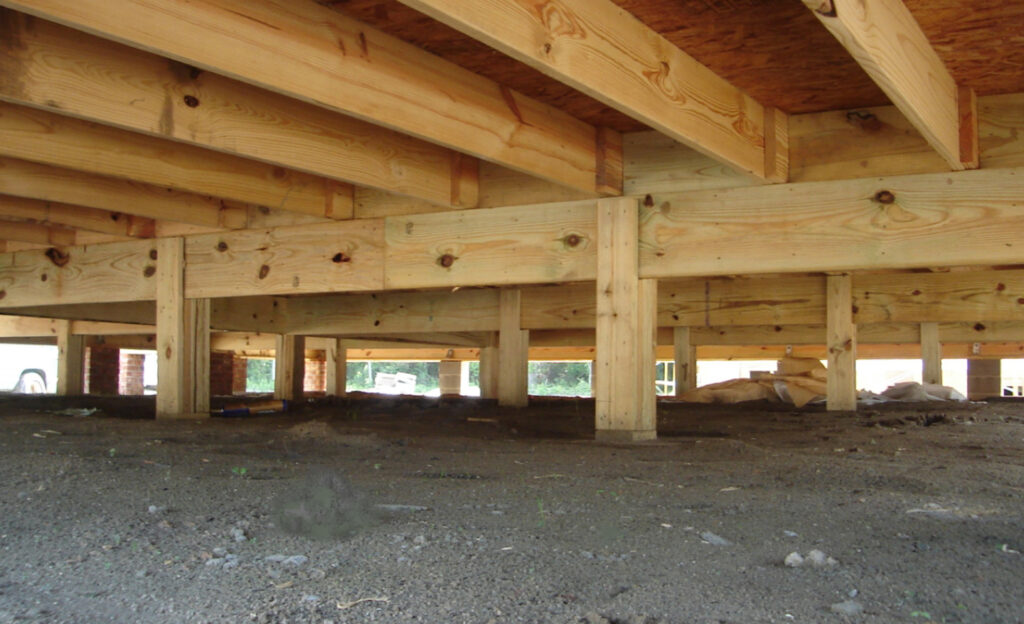What is a Raised Foundation:
Definition, Benefits, and Considerations

A raised foundation is a type of building construction technique. It’s one of the most important decisions to make when building a new home. Instead of placing a building directly on the ground, a raised foundation lifts it up. How does this work? A raised foundation involves constructing a structure on posts or piers to elevate the building above ground level. This design offers several benefits, including protection against floods, improved ventilation, and easier access for repairs. Throughout this post, we’ll explore raised foundations in detail, discussing their advantages, disadvantages, and everything in between. Buckle up for a deep dive into the world of raised foundations!
What is a Raised Foundation?
A raised foundation, also known as a pier and beam foundation, is a type of foundation commonly used in residential construction. It is a method of building a structure on piers or columns rather than directly on the ground. This elevated design creates a space or crawl space between the ground and the floor of the building.
Definition of a Raised Foundation
A raised foundation is a structural system where the weight of the building is supported by a series of piers or columns. These piers are constructed of concrete or wood and are spaced evenly throughout the perimeter of the building. The floor of the structure is then built on top of these piers, creating an elevated platform.
Purpose of Raised Foundations
The primary purpose of a raised foundation is to provide stability and support to a building. By elevating the structure above the ground, it helps protect against moisture damage, soil movement, and potential flooding. This type of foundation is particularly beneficial in areas with high water tables or soil prone to shifting.
Benefits of Raised Foundations
- Moisture Control: One of the main advantages of a raised foundation is the ability to control moisture levels. By creating a crawl space between the ground and the floor, it allows for proper ventilation and reduces the risk of moisture-related issues such as mold and rot.
- Accessibility: The space created by a raised foundation allows easy access to plumbing, electrical, and HVAC systems. This accessibility makes maintenance and repairs more convenient, as professionals can easily reach these components without the need for extensive digging or excavation.
- Insulation: Raised foundations can provide improved insulation compared to other types of foundations. The crawl space allows for the installation of insulation materials, which helps regulate the temperature inside the building and increases energy efficiency.
- Flexibility: Unlike slab foundations, raised foundations can be adjusted and modified more easily. If changes or additions need to be made to the plumbing or electrical systems, it can be done without major disruptions or extensive demolition work.
By utilizing a raised foundation, homeowners can enjoy the benefits of enhanced stability, moisture control, accessibility, insulation, and flexibility.
For more information on raised foundations and their construction, you can visit this helpful resource.
Types of Raised Foundations
Raised foundations are an important aspect of building construction, providing stability and support to structures. There are several types of raised foundations, each serving a specific purpose and catering to different building requirements. In this section, we will explore three common types of raised foundations: Pier and Beam Foundations, Crawlspace Foundations, and Stem Wall Foundations.
Pier and Beam Foundations
Pier and Beam foundations are a popular choice for residential buildings, especially in areas prone to soil movement or flooding. This type of foundation consists of piers, which are vertical columns of concrete or steel, and beams that span between the piers. The beams provide support for the structure above.
One advantage of pier and beam foundations is their flexibility. They can be adjusted easily, making them ideal for uneven or sloping terrain. Additionally, this type of foundation allows for easy access to utility lines, as they are often routed through the crawl space beneath the structure. This accessibility makes repairs and maintenance tasks more convenient.
Crawlspace Foundations
Crawlspace foundations, as the name suggests, create a crawl space between the ground and the bottom of the building. Instead of a solid concrete slab, this type of foundation uses footings and short walls to elevate the structure slightly above the ground level. The crawl space allows for easy access to plumbing, electrical systems, and other utilities.
Crawlspace foundations offer several advantages. They provide good ventilation, reducing the likelihood of moisture-related issues such as mold or rot. Additionally, the crawl space allows for easier maintenance and repairs to the building’s infrastructure. It also serves as a barrier against pests and prevents direct contact of the structure with the ground, reducing the risk of termite infestation.
Stem Wall Foundations
Stem wall foundations are a combination of concrete footings and masonry walls that support the structure above. The walls extend above ground level, providing additional strength and stability. Stem wall foundations are commonly used in areas with expansive soils or high water tables.
One of the key advantages of stem wall foundations is their ability to resist lateral forces, making them suitable for areas prone to earthquakes or high winds. The masonry walls can be reinforced with steel bars for enhanced structural integrity. Additionally, stem wall foundations can accommodate different types of flooring systems, such as concrete slabs or raised floors.
By understanding the different types of raised foundations, you can make an informed decision when it comes to building or renovating a structure. Whether it’s pier and beam foundations, crawlspace foundations, or stem wall foundations, each type offers unique advantages based on the specific requirements of your project.
Stay tuned for the upcoming sections of this article, where we will explore more fascinating aspects of raised foundations and their importance in the construction industry.
Key Components of a Raised Foundation
A raised foundation is a type of construction method used in building structures that involves elevating the building above the ground level. This technique provides several advantages, including protection against flooding, improved ventilation, and easy access to plumbing and electrical systems. In this article section, we will explore the key components that make up a raised foundation: footings and piers, beams and joists, and subflooring.
Footings and Piers
Footings and piers are the foundation elements that provide stability and support for the raised structure. Footings are typically made of concrete and are placed below the frost line to prevent the soil from shifting during freezing temperatures. They distribute the weight of the building evenly, preventing settling or sinking.
Piers, on the other hand, are vertical structural elements that are spaced throughout the foundation. They serve as additional support points, helping to distribute the load of the building and transfer it to the footings. Piers can be made of concrete, steel, or wood, depending on the specific design requirements.
When constructing a raised foundation, it is crucial to ensure that footings and piers are properly installed and adequately spaced to provide optimal support for the structure. Professional contractors or engineers should be consulted to determine the appropriate size and spacing of these components based on the specific building requirements.
Beams and Joists
Beams and joists are horizontal elements that work together to create a sturdy framework for the raised foundation. Beams, also known as girders, are large, load-bearing components that span the width of the building. They are typically made of wood, steel, or concrete and are placed directly on top of the piers. Beams provide crucial support for the weight of the structure and help distribute it evenly.
Joists are smaller horizontal elements that run perpendicular to the beams. They are typically made of wood or engineered materials and are placed on top of the beams. Joists provide a surface on which the subflooring and ultimately the flooring of the building will be installed. They also help distribute the weight evenly and provide additional stability to the structure.
Proper installation and alignment of beams and joists are essential to ensure the strength and durability of the raised foundation. The size and spacing of these components will vary depending on the specific building design and local building codes.
Subflooring
Subflooring is the layer of material that sits on top of the joists and provides a stable, even surface for the finished flooring. It adds structural strength to the raised foundation and helps distribute the weight of the building and its occupants.
The most common material used for subflooring is plywood or oriented strand board (OSB). These materials are engineered to be strong and resistant to moisture, ensuring the longevity of the foundation. Subflooring is typically installed in multiple layers to increase its strength and stability.
In addition to its structural role, subflooring also acts as a barrier against moisture and helps to reduce noise transmission between floors. It provides a solid foundation for various types of flooring, such as hardwood, laminate, or tile.
By understanding the key components of a raised foundation, such as footings and piers, beams and joists, and subflooring, you can appreciate the importance of these elements in providing stability, durability, and functionality to the structure. Proper installation and maintenance of these components are crucial to ensure the longevity of the raised foundation and the overall building.
Advantages of Raised Foundations
Raised foundations, also known as pier and beam foundations, offer several advantages over other types of foundations. In this section, we will explore three key benefits of raised foundations: enhanced air circulation and ventilation, protection from moisture damage, and easy access for maintenance and repairs.
Enhanced Air Circulation and Ventilation
One of the major advantages of raised foundations is the enhanced air circulation and ventilation they provide. Unlike slab foundations that are in direct contact with the ground, raised foundations elevate the house above the ground level, allowing air to flow freely beneath the structure. This natural airflow helps to prevent the buildup of moisture and reduces the risk of mold and mildew growth.
By creating a gap between the ground and the house, raised foundations allow air to circulate, keeping the space beneath the floor dry and well-ventilated. This is especially beneficial in areas with high humidity levels or heavy rainfall, as it helps to minimize the chances of moisture-related problems in the structure.
Protection from Moisture Damage
Another advantage of raised foundations is their ability to provide protection against moisture damage. Ground moisture can be a significant threat to the structural integrity of a house. However, with a raised foundation, the risk of moisture seeping into the structure is greatly reduced.
The elevated design of raised foundations helps to keep the main structure of the house above the ground level, minimizing the chances of water infiltration during heavy rains or floods. This can be particularly beneficial in areas prone to flooding or where the water table is high.
Additionally, raised foundations often incorporate a vapor barrier, which further protects the structure from moisture. This barrier acts as a shield against ground moisture by preventing it from entering the living space above. By mitigating the risk of moisture damage, raised foundations contribute to the longevity and durability of the house.
Easy Access for Maintenance and Repairs
One of the practical advantages of raised foundations is the easy access they provide for maintenance and repairs. Unlike slab foundations that require extensive excavation to access the plumbing or electrical systems, raised foundations have an accessible crawl space.
The crawl space beneath the house allows homeowners and professionals to easily reach and inspect the various components of the house’s infrastructure. This includes plumbing lines, electrical wiring, and HVAC systems. With this convenient access, routine maintenance and repairs become simpler and more cost-effective.
Moreover, the crawl space facilitates the installation of utilities and makes it easier to address any issues that may arise in the future. By providing easy access for maintenance and repairs, raised foundations help homeowners save time and money on home improvements and ensure the longevity of their property.
Considerations for Raised Foundations
Raised foundations are a popular choice for homeowners looking to elevate their homes above ground level. This type of foundation offers several advantages, including protection against flooding, improved ventilation, and easier access to plumbing and electrical systems. However, before deciding to opt for a raised foundation, there are some important considerations to keep in mind.
Soil Conditions and Site Preparation
One of the primary factors to consider when planning a raised foundation is the condition of the soil on your property. The stability and load-bearing capacity of the soil will directly impact the design and construction of the foundation. Conducting a thorough soil analysis is crucial to determine if any modifications or reinforcements are needed.
During site preparation, it is essential to level the ground and remove any debris or vegetation. This ensures a stable base for the foundation and minimizes the risk of settling or shifting over time. Additionally, proper drainage should be considered to prevent water accumulation around the foundation, which can lead to structural damage.
Building Codes and Regulations
Complying with local building codes and regulations is of utmost importance when constructing a raised foundation. These codes are in place to ensure the safety and structural integrity of the building. They typically outline specific requirements for foundation design, materials, and construction methods.
Before proceeding with the construction, it is advisable to consult with a professional architect or engineer who is familiar with local building codes. They can guide you through the permit application process and help ensure that your raised foundation meets all necessary requirements.
Costs and Maintenance Requirements
When considering a raised foundation, it’s crucial to evaluate the associated costs and maintenance requirements. While the initial construction costs may be higher compared to other types of foundations, the long-term benefits often outweigh the investment.
Regular maintenance is essential to keep the foundation in optimal condition. This may include periodic inspections, addressing any moisture issues promptly, and maintaining proper grading and drainage around the foundation. Neglecting these maintenance tasks can lead to costly repairs down the line.
It is also worth noting that the cost of raised foundation construction can vary depending on factors such as the size of the house, soil conditions, and local labor costs. Obtaining multiple quotes from reputable contractors and comparing the pricing and services offered can help you make an informed decision.
Remember, before proceeding with the construction of a raised foundation, it is vital to conduct thorough research, consult with professionals, and carefully consider the soil conditions, building codes, associated costs, and maintenance requirements. By taking these considerations into account, you can ensure a sturdy and reliable foundation for your home
Conclusion
In conclusion, a raised foundation is a type of construction technique commonly used in areas prone to flooding or with unstable soil conditions. It involves elevating the main structure of a building above ground level, typically using concrete piers or columns. Raised foundations provide several benefits, including improved protection against water damage, increased stability, and easier access for maintenance and repairs. They are especially beneficial in regions where heavy rainfall or high water tables are common. By understanding the importance and advantages of raised foundations, homeowners and builders can make informed decisions when it comes to constructing or purchasing a property.





